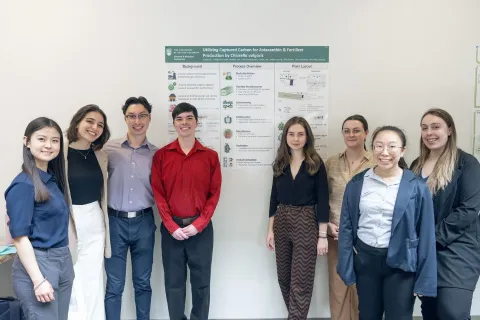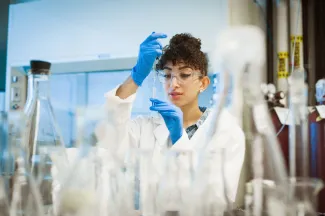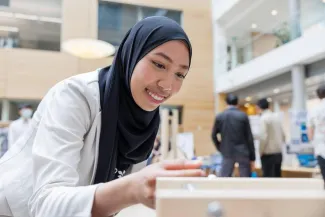
Meghan Cooke, Amelia Dai, Lisa Hochhausen, Cindy Lam, Adam Leung, Siba Saleh, Chris Webster and Veronika Zenova
- Community Partner: Teck Resources
- Degree:
- Bachelor of Applied Science
- Program:
- Campus: Vancouver
Our design solution
One of our first decisions was choosing which end products we would produce from the algae. We chose astaxanthin, which is a pigment that can be used as an antioxidant for preservative purposes. The remaining biomass would be packaged as biofertilizer to minimize waste and maximize profitability.
We developed a process to grow the algae in flat-plate photobioreactors capable of consuming 33,500 kilograms of carbon dioxide over a batch time of 200 hours. This was followed by a series of processes to harvest cells, disrupt cell walls to release the astaxanthin, purify the product, and finally formulate the product as a powder.
We selected the equipment to perform these tasks and designed our plant layout accordingly. Other elements included estimating total capital costs and annual operating costs, as well as projected profit from astaxanthin and fertilizer sales. Finally, we also conducted safety and environmental assessments for the operation.
Early in the project, we realized that it would be incredibly difficult to sequester 100,000 tonnes per year of carbon dioxide using Chlorella vulgaris. We worked through numerous scenarios, and in the end, we designed a process and facility that could result in the biological sequestration of 2,000 tonnes of carbon dioxide annually. Even so, to achieve this, our facility would need to be very large – about the size of six football fields and with a four-storey-tall greenhouse – and would require considerable investment.
What excited us most
Carbon capture will be an important way forward for all industries in the face of climate change, and it was exciting to learn more about what elements need to be in place to make biological carbon sequestration feasible.
It was also rewarding to synthesize all the knowledge we have gained over the years – from thermodynamics to biological engineering – and bring it all together here.
Finally, this project demonstrates the significant role chemical and biological engineers play in making the environment a better place for all. As engineers working in this field, we can make a difference in renewable energy, pharmaceuticals, the food industry and a wide array of other areas.

Why engineering is the most versatile degree?
Engineering degree offers a well-rounded education in science, math, design skills, communication, and entrepreneurship. Additionally, it serves as a strong foundation for success in various fields such as medicine, law, business, academia, and more.





